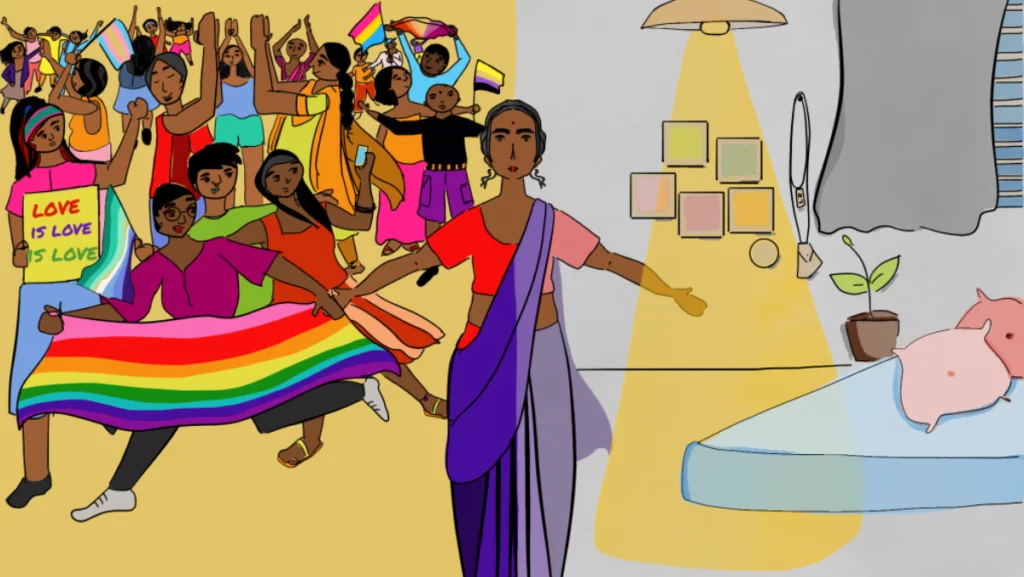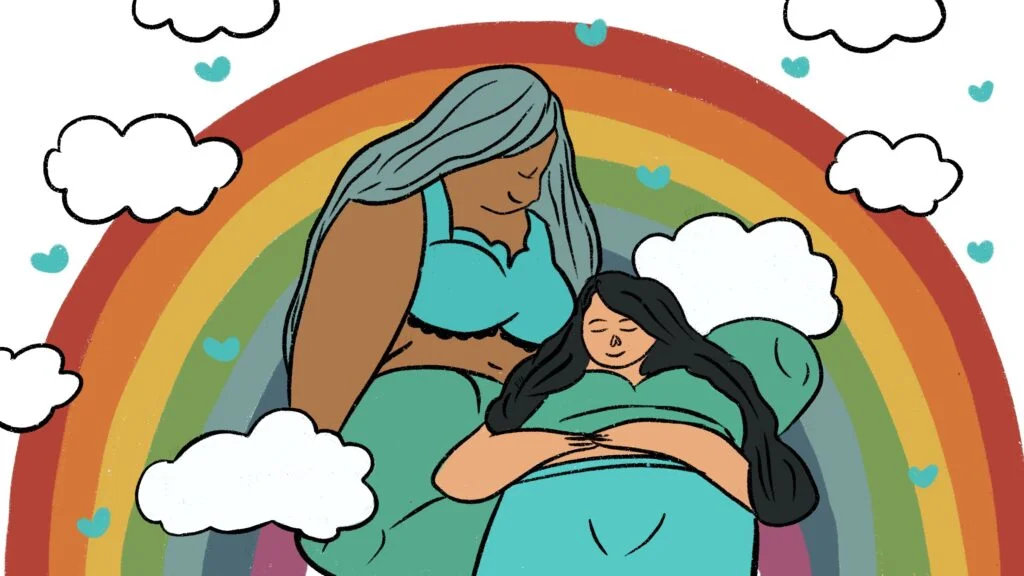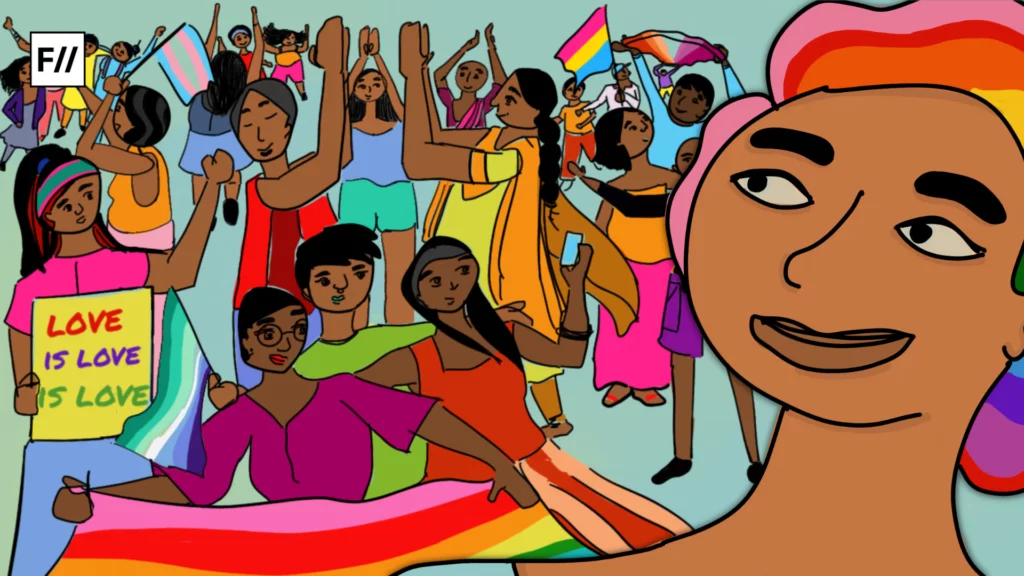On the 23rd of May this year, when Colors TV announced the trailer of a show called Krishna Mohini with a Pride March sequence, queer viewers had many mixed thoughts. The trailer starts with a child who enters Pride March and asks what the event is. Two trans characters reply that they were assigned another sex at birth and they managed to get a gender reassignment surgery and attain their true identities, regardless of what people thought. The trans femme person looks at the child and remarks that even the child carries an internalised dilemma within themselves. Then the family members of the child pull them away in anger.
The trailer drew many mixed reactions. While some queer people were thrilled, some were even scared that it sought to stigmatise the queer community.
The visible saffronisation of the title notwithstanding, the trailer seemed like a very important conversation starter that would reach all sections of society.
The visible saffronisation of the title notwithstanding, the trailer seemed like a very important conversation starter that would reach all sections of society. Firstly, the conversation on queerness as an organic identity that starts at any age, is very important. Many queer people suffer this conundrum where bullying at schools and colonies in their childhood made them grow up as closeted versions of themelves, only to come out after the removal of many draconian laws against queer people.

Many times, the closet was just a flimsy tent, or just non-existent. Queer people just learned to mask. When queer people would come out to parents at their convenience – let’s say during adulthood – the parents would say that it’s just a trend or a recent jump on a trending bandwagon. Our elders want queerness to be something that ideally never “happens” or in the worst case, something that happens only after 18. That’s not how it works. It can manifest early on and needs gender-affirming interventions – not necessarily medical – to enable children to function comfortably.
The pre-existing misconceptions about the queer community
Furthermore, Indian parents look at LGBTQ people as secluded groups of people, the narrative of which is spread by this damaging article by the Jaipur dialogues. They say, ‘In India, the LGBT community has its own space of existence. The homosexual couple choose their sexual preference without advertising it in public. The transgenders or Kinnar Samaj also love, live, and work within the regular bounds of Indian society without disrupting it or demanding special rights…’
This article just furthers the Indian mindset that fails to realise that queer people aren’t closeted people found in pockets of Indian society. They’re everywhere – the quiet neighborhood child, the aloof uncle on the second floor who’s been closeted all life, or the energetic teammate on your project. They have every right to be open about their identity.
Furthermore, Indian parents look at LGBTQ people as secluded groups of people, the narrative of which is spread by this damaging article by the Jaipur dialogues.
It isn’t about advertisement, but asserting dignity for oneself and living an authentic life without shame. The article talks about Kinnar Samaj working within the regular bounds of society, but they deliberately ignore the nature of the work done. How many Kinnar people do we know who occupy high positions in hospitals, judicial offices, or schools? (to name a few). In this very article, the author admits that their blessings are considered auspicious. We want people to get the narrative that trans* people aren’t just baby blessers but deserve gender-affirming facilities at places of education and work to achieve rights to the same extent as cis people.

Besides, Indian parents don’t know the difference between trans and gay. They don’t even understand that trans and intersex are two different things. Jyotsna Tiwari, the cis-het woman who made a botched-up version of the Transgender manual for NCERT used the term ‘transgender by birth’. Many conservatives, including Aparna Lalingkar, the government appointee for the National Commission of Trans People think intersex people are the real trans people and gender dysphoric trans people are fake trans people. Many gay children who came out to their parents as gay were asked if they were “Kinnar”. Such shows can elucidate complicated terminology about gender and sexuality to Indian parents and make them aware of the differences.
The challenges with Krishna Mohini
While the idea of this show seems appealing to many of us queer people, it can also horribly go wrong. It can end up demonising queer people far more than normalising queerness, especially since the run time of a TV show is longer than a film. It shouldn’t end up becoming the case of “too little too late” playing out, where the idea of awareness has arrived after solidifying in people’s minds the same stereotypes that we’ve tried hard to avoid. There is also the additional fear of the show and characters’ conflating terms, increasing confusion in the audience.
Shakti – Astitva Ek Ehsaas Ki may have started with good intentions but ended up making a mess of the show. Many queer people watch this show to analyse the portrayal of a queer character. While the idea of an intersex character seemed novel, the intersex angle has not been approached correctly and has been wasted as just another stereotype.
Shakti – Astitva Ek Ehsaas Ki may have started with good intentions but ended up making a mess of the show.
It conflated intersex with trans, demonised the trans community/Kinnar Samaaj as kidnappers, and showcased none of the difficulties experienced by the intersex community in terms of forced surgeries during infancy and lack of informed medical care. Another catch was the casting of an actress like Rubina Dilaik who was clueless about the identity of the character she played. In some interviews, she’s mentioned that it’s a trans* character, and in some others, the word “intersex” has been mentioned, which are two different things.

Krishna Mohini should learn from these examples and work on a clear concept. Having LGBTQ people on a panel and queer actors to discuss before every episode and clarify doubts regarding gender identity and expression, biological sex and sexual orientation, gender dysphoria, and intersex conditions can help the creation of informative and accurate content without creating mockery or phobia eliciting character tropes.
This show can truly change the landscape of Indian television concerning understanding queerness, provided conservative Indians let this show run, and provided it truly translates into natal acceptance of transgender children.






